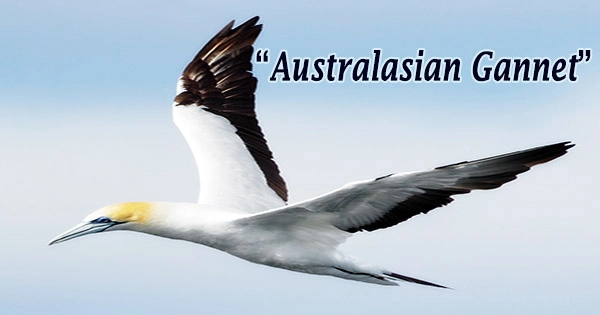Only three gannet species exist in the world: the Australasian gannet (Morus serrator), commonly known as the Australian gannet or tkapu. It is a big seabird belonging to the Sulidae family, which includes boobies and gannets. Adults are mainly white, with black flying feathers running the trailing edge of the wing and at the wingtips. Throughout the year, these species may be found in eastern, southern, and western Australia’s inshore waters. They reproduce in loud colonies, which are generally found on islands or man-made structures like lighthouses. A colony at Portland in southwestern Victoria, however, is located on a peninsula that protrudes from the mainland. Only two additional mainland colonies exist, both in New Zealand. Gannets forage by diving headfirst into the water from tremendous heights in order to grab fish in their bills, then resurface to consume their meal. The black tail feathers in the center are also present. With a pale blue-grey bill edged in black and blue-rimmed eyes, the head is tinted buff-yellow. In their first year, young birds exhibit mottled plumage with black above and light below. The beak is black and the head is an intermediate speckled grey. In succeeding seasons, the birds gradually gain more whiteness until they achieve maturity after five years. They only dive for approximately 10 seconds, but the fish is usually consumed before the bird reaches the surface. Plunge divers and outstanding fishermen, these birds dive into the ocean at great speeds. Squid and forage fish that congregate near the surface are their major sources of food. The species has minimal natural or man-made dangers, and the International Union for Conservation of Nature (IUCN) considers it a least-concern species because of its rising population.

The plumage of the male and female Australasian Gannets is very similar. The main wing feathers and the inner tail feathers have black tips, and the rest of the body is white. The bill is pale blue-grey with dramatic black edges on the bill sheaths, and the head is buff-yellow. Adult Australasian gannets measure 84–91 cm (33–36 in), weigh 2.3 kg (5.1 lb), and have a wingspan of 170–200 cm (67–79 in). The head and upper parts of juvenile birds are mainly dark with splotches of white marking. Small groups of birds may be seen soaring over the ocean, with one bird folding its wings back and diving dramatically into the sea. The bill of an adult is pearly grey with dark grey or black edges and a black groove running along the upper mandible’s length. The four-toed feet are dark grey in color and are connected by a membrane of the same hue. There are pale green lines running up the front of the legs and along the ridges of the toes. Australasian Gannets are expert fishers. Birds swoop up to 10 meters above the water’s surface, herding fish into thick shoals, before folding their wings and diving into the water to grab their food. Small backward-pointing serrations around the bill’s margins help the fish to be grabbed. Although a bird only stays submerged for approximately 10 seconds, the fish is usually consumed before the bird reaches the surface. This species is different, and only species that do not share its distribution are likely to be mistaken with it. The Cape gannet, which has an all-black tail, is a rare vagrant to Australasian seas, whereas the masked and red-footed boobies are limited to tropical areas. They lack the buff coloration of the head and have whitetails while having mainly white plumage. The red-footed booby has red feet, whereas the masked booby has a blue-black face and less black on the wing. Australasian Gannets may be found throughout southern and eastern Australia, as well as New Zealand. After the nesting phase, the Australasian Gannet stays in the area of the colony. The young scatter and can travel over 2500 kilometers in a week. A large number of people migrate north along the western and eastern Australian beaches. Pairs of gannets may stay together for several seasons. They extend their bills and necks skywards and softly tap their bills together in intricate welcoming rituals at the nest. Adults tend to stay near to their colonies, while young birds disperse. One egg weighing between 84 and 125 g (3.0 to 4.4 oz) is deposited, with an average of 99.8 g. (3.52 oz). It is 65–89 millimeters (2.6–3.5 in) length by 35–53 millimeters (1.4–2.1 in) broad and has an elongated egg form. When dried, the egg surface becomes white and has a chalky covering. In most seasons, only one brood is produced, however, eggs and chicks up to eight days old will be replenished if they are lost. The female does the majority of the incubation, keeping the eggs warm on top of its webbed feet for 37–50 days. It takes around six or seven years for the young to achieve breeding maturity. Plunge divers and outstanding fishermen, these birds dive into the ocean at great speeds. They consume mostly squid and forage fish that congregate near the surface.
















